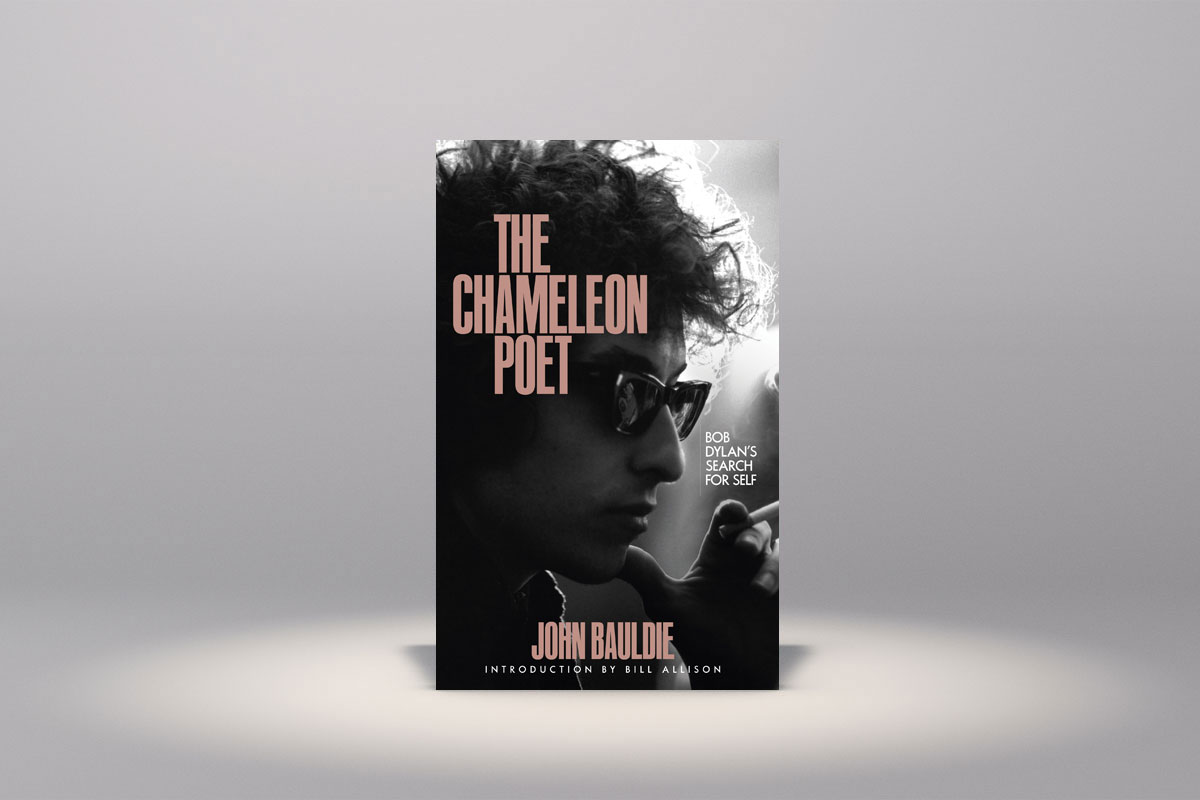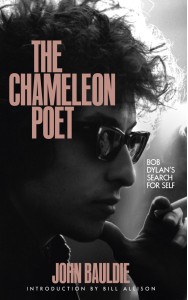An extract from John Bauldie's The Chameleon Poet: Bob Dylan's Search For Self. Here John looks at Bob Dylan's 'Tangled Up in Blue' from the album Blood on the Tracks, drawing comparisons with Hermann Hesse's novel Steppenwolf.
It strikes me funny that people actually have the gall to think that I have some kind of fantastic imagination. It gets very lonesome.
— Bob Dylan, Playboy, May 1966
Bob Dylan can scarcely have felt more alienated from himself than he did in late 1974. Having once again adopted the persona of the public performer with the US tour, he found himself facing separation and, ultimately, divorce from Sara. In order to achieve some kind of perspective on himself and on his situation, Dylan found it necessary to go outside of himself and become completely objective – to become, in fact, completely egoless and thus achieve the goal of self-assessment which had previously eluded him.
Such self-assessment requires total honesty, and only complete objectivity can aspire towards that. The songs written for Blood on the Tracks include naked self-portraits. Some contain assessments of Sara and the relationship, which is accepted as being at an end. Other songs separate, for the first time, Sara and the ‘other’ woman figure of whom Dylan has long been in search. Just as Renaldo and Clara attempts to separate Dylan the artist (Renaldo) from Dylan the public figure (Bob Dylan), so Blood on the Tracks attempts a similar separation of identity and thus aspires finally towards self-definition in such songs as ‘Tangled Up in Blue’ and ‘Simple Twist of Fate’.
‘Tangled Up in Blue’, the album’s opening song, presents a retrospective account and analysis of a relationship that is both autobiographical and mythical. Through his relationship with Sara, Dylan sees himself as being in communication with all women, or with the essence of femininity. Although Sara is – or has been – his alienated opposite, such a figure exists beyond her and can be found in other women, at other times and in other places. When he sings ‘I seen a lot of women but she never escaped my mind’, he admits this indirectly. The ‘she’ he cannot forget or escape from is his other half, who exists not as a separate entity from the many women he’s seen, but as a part of them. She was a part of Sara too, who is necessarily included in the song’s opening:
She was married when we first met
Soon to be divorced.
There are other directly autobiographical glimpses of Dylan’s past:
I lived with them on Montague Street
In a basement down the stairs
There was music in the cafés at night
And revolution in the air.
And of his present:
Me, I’m still on the road
Headin’ for another joint.
The song operates on the mythic level too, though. Dylan weaves into the song a fictitious past for himself, drifting from place to place, from job to job, and from time to time encountering the ‘she’ to whom it is his destiny to be forever linked. The central section of the song presents one such encounter in ‘a topless place’. Again Dylan perhaps owes more than a little to Hermann Hesse’s Steppenwolf as he presents himself stopping into the bar for a beer. In Steppenwolf, Harry Haller, suffering ‘nausea, agony and despair’ finds himself wandering from bar to bar, ending up at The Black Eagle, where he too has a ‘chance’ encounter with a woman: ‘She gave me a friendly and observant look as I came up and with a smile moved to one side to make room for me.’ The first thing she does is to wipe Harry’s dirty glasses before she turns her attention to his dirty shoes: ‘She took me under her wing just as I needed … she filled my glass.’ All the while Harry looks at her, ‘I could not tell of whom it was she reminded me’, whilst she correctly identifies him as an academic whose studies have meant that he never learned to enjoy himself. Eventually, Harry can contain his curiosity no longer:
‘But now, I really must know your name.’
She looked at me for a moment without speaking.
‘Perhaps you can guess it. I should be glad if you did. Pull yourself together and take a good look at me. Hasn’t it ever occurred to you that sometimes my face is just like a boy’s? Now, for instance.’
Yes, now that I looked at her face carefully, I had to admit she was right. It was a boy’s face. And after a moment I saw something in her face that reminded me of my boyhood and of my friend of those days. His name was Hermann. For a moment it seemed that she had turned into this Hermann.
‘If you were a boy,’ said I in amazement, ‘I should say your name was Hermann.’
‘Who knows, perhaps I am one and am simply in woman’s clothing,’ she said playfully.
‘Is your name Hermine?’
She nodded, beaming, delighted at my guess.
The parallels in the encounter in ‘Tangled Up in Blue’ should be clear enough. Dylan sings of his fascination with her face, which he ‘just kept lookin’ at’. She approaches him and asks ‘Don’t I know your name?’121 Her fascination with his face corresponds with his for hers, whilst his diffidence and uneasiness, and her care for him – ‘she bent down to tie the laces of my shoe’ – echo Steppenwolf exactly. Hermine plays records for Harry; the woman in Dylan’s song offers a book of poems by a thirteenth-century Italian poet – maybe Dante (whom Dylan speaks of having read in the 1968 Sing Out! interview) maybe Petrarch (whom Dylan is to confuse with Plutarch in the 1978 Jonathon Cott interview from Rolling Stone). In either case:
Everyone of them words rang true
And glowed like burning coal
Pourin’ off of every page
Like it was written in my soul.
It may be that Dylan had in mind Baudelaire’s ‘Le Balcon’ here, in which the poet recalls similar evenings spent with his own ‘mother of memories, mistress of mistresses … we often said things that never will perish, on these evenings illumined by the glowing coal’.
The association with Baudelaire is confirmed when in a 1978 concert, Dylan sings:
She opened up a book of poems
And shouted it to me
Written by Charles Baudelaire…
Harry Haller, in Steppenwolf, is an obvious persona of his creator, Hermann Hesse. The narrator of ‘Tangled Up in Blue’, in the officially released version of the song, speaks in the first person and thus can be confused with his creator. In the originally recorded version – one of five cuts not used on the album release – it is still ‘I’ who has the encounter in the topless place, but the rest of the song speaks of ‘he’; in live recordings of the song, Dylan seemingly alternates ‘I’ and ‘he’ at random. As I’ve already pointed out, the song combines both factual and fictitious autobiography and operates on real and mythic planes concurrently. Both Dylan and Hesse separate person and persona in their art. ‘Hermine’ is Harry’s ‘twin sister’, the feminine image of himself; she cares for him as a wife, sister and mother, and thus assumes symbolic proportions. As the novel progresses, Hermine’s identity melts from that of ‘a woman’ into ‘womankind’ until Harry finally consummates a symbolic marriage to her, which represents the complete welding of all aspects of his nature. The extracts from their meeting quoted above indicate that Hermine is not separate from, but part of Harry and, by implication, Hesse’s personas.
In ‘Tangled Up in Blue’, the meeting of the song’s narrator with the woman in the bar is an exact parallel. She approaches him, dominates him, mothers him, loves him. Because she is the feminine part of his own nature, her communication with him through the book of poems is directly with his soul. To realise himself fully, he must embrace her and absorb her. One of Jung’s symbols for the self is the hermaphrodite. In ‘Tangled Up in Blue’, Bob Dylan presents a mythologised version of his male role – working in the Great North Woods, or on a fishing boat, or, in the original version of the song, ‘loading cargo on to a truck’ at an ‘airplane plant’. He projects his femininity – his emotional poetic nature – on to the mythic ‘she’ who offers back to him a book of poems which seems as though ‘it was written in my soul from me to you’. She is, and always has been, and always will be, a part of him. She knows that any separation is temporary – ‘we’ll meet again someday’ – for she truly is his ‘other half’, the ‘missing piece’ of the total self, of which both ego and anima are merely parts.

